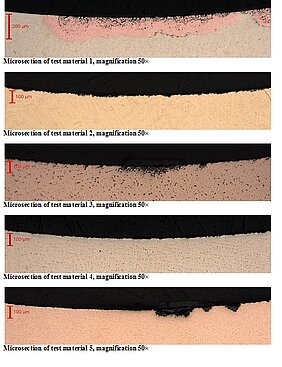In the project, comparative tests were performed on the behaviour of newly developed non-leaded copper-based materials. Using the results, their application limits in terms of corrosion resistance and metal discharge should be determined, taking into account varying water quality compared with an established material.
Due to new statutory requirements relating to the discharge of lead from copper-based materials, not all of the materials used to date can continue to be used without restriction. In fact there are novel material developments that contain either reduced lead or hardly any lead at all (non-leaded brass materials).
On behalf of the US-American Water Research Foundation (WRF), a research project was undertaken at TZW to investigate the behaviour of the new materials in terms of material-hygienic aspects and aspects of corrosion resistance. Four non-leaded materials were tested and compared with a conventional material. Different standardised short-term and long-term test methods were used. In terms of the leaching behaviour, these materials were greatly improved compared with the red brass reference material. For corrosion resistance (stress corrosion and erosion corrosion), these materials also met the requirements of the relevant standards.
In the short-term dezincification test, no relevant dezincification was determined for any of the tested materials. Three of the four non-leaded brass materials showed equivalent or superior behaviour to the reference red brass in the long-term dezincification tests. One non-leaded material showed a dezincification depth of approx. 200 µm, which can be considered significant for some applications. In principle, all four of the tested non-leaded brasses are suitable for use in drinking water. However, in local waters with a considerable dezincification potential (water with low alkalinity, high chloride and/or sulphate concentrations), long-term tests are recommended to confirm the performance of the provided materials.

![[Translate to English:] Prüfstelle-Produktprüfung_Teststand Test centre and product testing](/fileadmin/_processed_/0/9/csm_TZW-Karlsruhe_Pruefung_Geraete-Teststand_377188946c.jpg)
























